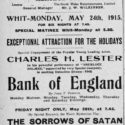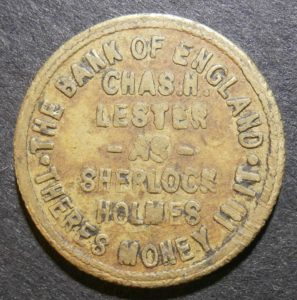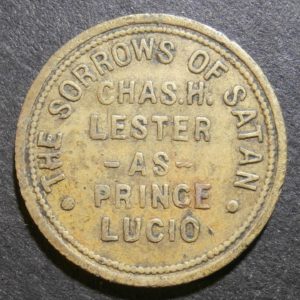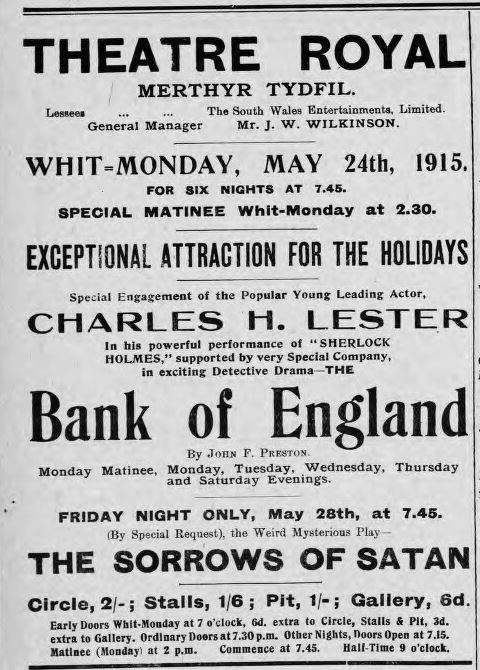A Scion Society of The Baker Street Irregulars

The Mysterious Case of the Army Uniform
“We were to go to the theatre.”
– The Adventure of the Bruce-Partington Plans (BRUC)


I recently acquired a theatre check and on one side it advertises “The Sorrows of Satan” starring “Chas. H. Lester as Prince Lucio”. But it was the other side that was much more intriguing, for around the rim it proclaimed “The Bank of England, There’s Money In It” and the same “Chas. H. Lester”, this time playing none other than Sherlock Holmes. Clearly further investigation was required.
“The Bank of England” was a “substantial four act melodrama” by Max Goldberg, who wrote and performed in the original production under the pseudonym John. F. Preston. The “unauthorised” play opened at the Shakespeare Theatre, Clapham in November of 1900. This makes Goldberg the sixth-ever actor to portray Holmes in a major theatrical production, pre-dating William Gillette’s first appearance by ten months (Wilcockson, 2014).
In 1902, Walter Bentley toured with the play in Scotland with appearances in Falkirk, Ardrossan and Dunfermline. Bentley (born William Begg, in 1847, in Edinburgh) was possibly the first Scotsman to play Holmes. In the 1890s, he toured Australia and New Zealand in numerous productions, eventually settling in Brisbane, Queensland. Bentley became a major figure in Australian theatre and was instrumental in establishing the Australian Actors’ Association (Walter Benley (actor), 2017).
There are records of the “Bank of England” being played in New Zealand in 1904, with Charles Blake in the lead role, and at the King’s Theatre, Melbourne, in 1909, this time with Roy Redgrave playing Holmes.
The Sherlock Holmes Actors documentation on the No Place Like Holmes website (Sherlock Holmes Actors Letter La-Le, 2017) lists Charles H. Lester as playing Holmes in the play as early as 1902, with appearances in 1903, 07, 09 and 15. We certainly know about the 1909 appearance, as there is a rather interesting report in the Dundee Evening Telegraph, dated Friday 1 October. Under the heading “For a Disguise” the article reports that
“Charles H. Lester theatrical manager, 9 Kinnaird Street, Dundee, has during the present week been appearing in the Empire Theatre, Dundee, in the drama, “The Bank of England,” in the role of Sherlock Holmes. This afternoon he appeared before Sheriff Campbell Smith on a contravention of the Army Act.” (Charles H. Lester, 2017)
It appears that David Craig, a millworker, had called in at the theatre the previous week to offer a soldier’s uniform for sale. Lester was busy rehearsing and asked Craig to return later, which he did. Mr. Lester was on stage at the time he called back and so he instructed the stage manager to make the purchase of the uniform. What Lester was clearly unaware of is that it was illegal to purchase an army uniform under the Army Act. For contravening the act he was fined six shillings. David Craig was also charged and was offered a fined of thirty shillings or twenty days in prison. It is unclear from the article which option Craig took, although considering that thirty shillings was a fair sum to a millworker, we can deduce he probably took the latter option.
I’ve found a review of the play from the first time it was performed in Australia, at the Palace Theatre in Sydney, in November 1903. This comes courtesy of our amazing Trove website, which is attempting to digitise all our old regional newspapers and is an invaluable research aid. Here’s a link to the article in Trove and here’s the text:
Palace — ‘Bank of England.’
Miss Fitzmaurice Gill on Saturday night produced the ‘Bank of England’ for the first time in Australia, by arrangement with Mr. W.J. Holloway. The following was the
CAST OF CHARACTERS :
Sherlock Holmes (Criminal Investigator): Mr. Chas. Blake
Sir Sidney Barraclough, Stephen Hartley (Directors of the Bank of England): Mr. Chas. Lawrence & Mr. Wilton Power
Hon. Bertie Burlington (A man about town): Mr. Lionel Walshe
Godfrey Dane, alias Sias Baxter (an engraver): Mr. David S. Clark
Eric (his Supposed son): Mr. J. S. Ryan
Gordon Isaacs (a money lender): Mr. John Cosgrove
Tommy Sprouts (a racing man): Mr. I.D. Chateau
Atherley Jones (a detective): Mr. Phil Redet
Jeames (a footman): Mr. Frank Pierce
Bank Clerk: Mr. Fred. Cairnes
Officer of the Guard: Mr. A. Devon
Lady Sylvia Barraclough (Sir Sidney’s Daughter): Miss Nellie Mylrea
Margaret Dane: Miss Hylda Evelyn
Lucy Locket (Mrs. Beane’s maid): Miss Fanny Thynne
and AMINTA J. JEANE (an American widow): MISS FITZMAURICE GILL
The author, whose name, by the way, was not stated, had a foundation upon which to construct a most interesting play, and he succeeded admirably In his work, though, unfortunately, in one or two instances more might have been made of the scenes had stage accommodation allowed of it. The first act shows the residence of one of the directors at Molesey Hurst, the second Sherlock Holmes’ chambers, the bullion cham bers of the bank, and the exterior of that noble institution. In the succeeding act the audience was again transferred to the chambers of the celebrated detective, and following this were given an idea of the In terior of the issue department of the bank. The final act showed the runs of Pevensey Abbey. Throughout these different locales the story unfolds itself interestingly, and a well-filled house followed the fortunes of the principals closely. Miss Fltzmaurice Gill had a good part, which did not by any means suffer in Its presentation. The star had adequate support, particularly from Mr.C. Blake, who also directed the production. Mr. John Cosgrove, Miss Fanny Thynne, Miss Nellie Mylrea, Miss Hilda Evelyn, Mr. Lionel Walsh, Mr.. Wilton Power, and Mr. J. S. Ryan. The production will only have a limited run.”
I do like how a numismatic item about Sherlock Holmes has revealed a numismatic related play about Sherlock Holmes. Spoilers, but I reckon the Engraver did it!

The year 1915 probably saw Charles hang up his pipe, but we do know that he was on a double bill at the Theatre Royal in Merthyr Tydfil in Wales (Merthyr Pioneer, 1915) in an “exceptional attraction for the holidays”. For not only was the audience able to admire “his power performance of Sherlock Holmes”, but they could also see him in “The Sorrows of Satan”. It’s probably this tour from which this check comes from.
References
(1915, May 22). Merthyr Pioneer.
Charles H. Lester. (2017, July 25). Retrieved from HISTORICAL & FICTIONAL CHARACTERS IN SHERLOCKIAN PASTICHES: http://www.schoolandholmes.com/theatre/lestercharles.html
Sherlock Holmes Actors Letter La-Le. (2017, July 25). Retrieved from No Place Like Holmes: http://www.nplh.co.uk/uploads/7/3/3/6/7336521/sherlock_holmes_actors__letter_la-le.pdf
Walter Benley (actor). (2017, July 25). Retrieved from Wikipedia: https://en.wikipedia.org/wiki/Walter_Bentley_(actor)
Wilcockson, R. (2014, December 18). Markings. Retrieved from http://altamarkings.blogspot.com.au/2014/12/
One addendum that’s worth noting,

I have just found a token that reads the sorrows of satan,chas h lester as prince lucio, on the other side reads, a life for a life,come and see josh harker and his baby detective.